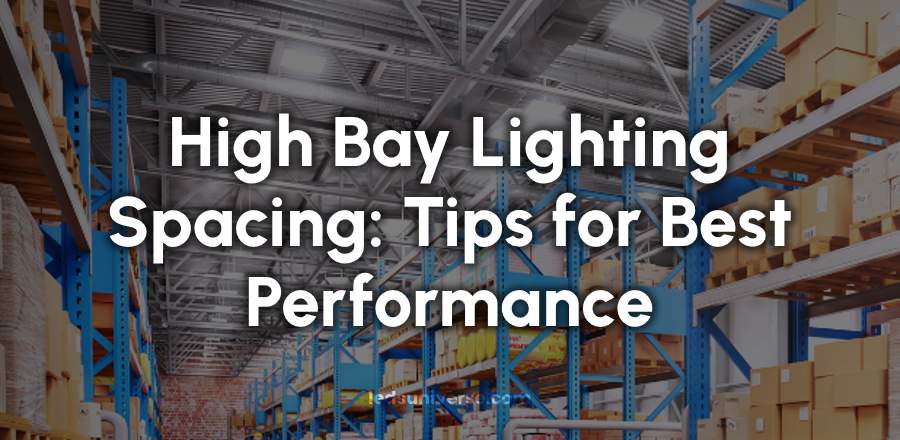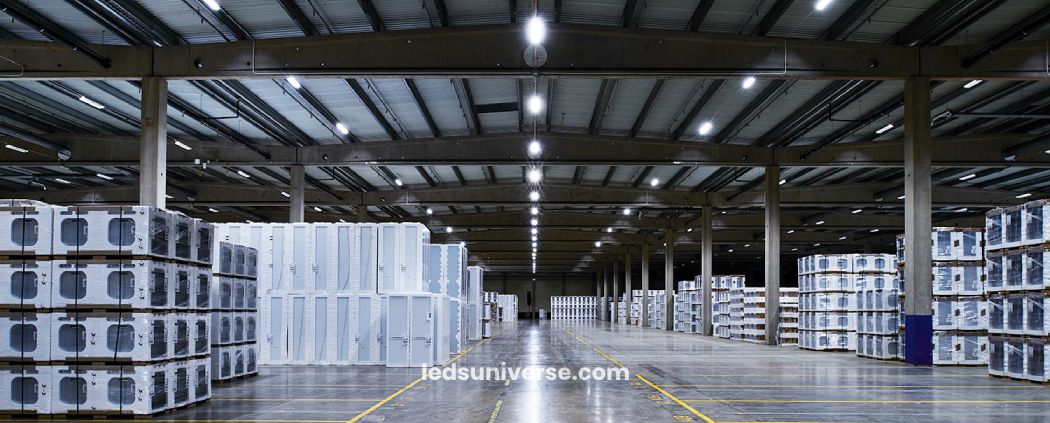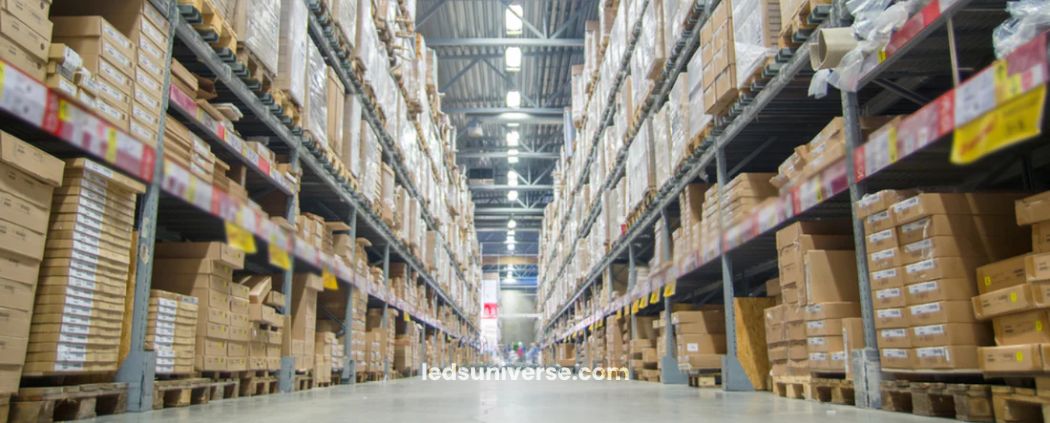
In the vast expanse of a bustling warehouse or the soaring ceilings of an expansive gym, high bay lighting emerges as a beacon of clarity and purpose. It transforms dim, shadowy corners into bright, inviting spaces where safety and productivity reign supreme. Designed specifically for lofty ceilings, high bay lights illuminate large areas with a brilliance that not only enhances visibility but also shapes the very atmosphere of the environment.
High bay lighting is a specialized lighting solution designed for spaces with high ceilings, typically ranging from 12 to 40 feet. This type of lighting is crucial in various applications, such as warehouses, factories, gyms, and large retail spaces. In these environments, proper visibility is essential for ensuring safety, enhancing productivity, and creating an inviting atmosphere. High bay lighting not only illuminates expansive areas but also ensures that workers can see clearly while performing their duties.
Reach out for free lighting consultation
Table of Contents
ToggleHigh bay lighting is distinguished by certain characteristics that set it apart from other types of lighting. One of the most defining features is its installation height. High bay lights are specifically designed to be installed at elevated positions, typically above 12 feet, but often extending to 40 feet or more. This height creates unique challenges and opportunities for illumination. The installation height affects the choice of fixtures and the lighting design strategy. For instance, fixtures must be selected not only for their light output but also for their ability to distribute light effectively over a large area. Understanding the appropriate mounting height is critical for ensuring optimal visibility and avoiding dark spots in the workspace.
The light output is another fundamental characteristic. High bay fixtures must produce sufficient lumens to adequately illuminate large areas, particularly in industrial settings where visibility is paramount. The amount of light required varies based on the specific application; for example, a manufacturing floor may require a different lumen output than a retail space. Additionally, the distribution of light is crucial. Light must be evenly spread across the entire area to minimize shadows and ensure a safe working environment. Factors such as fixture placement, beam angle, and the reflective surfaces in the area can influence how effectively light is distributed. Evaluating these factors helps in achieving an appropriate balance between light intensity and uniformity.
Color temperature is another characteristic that affects the performance of high bay lighting. Measured in Kelvins (K), color temperature influences the ambiance of a space and can impact worker productivity and comfort. Cooler white light, typically above 5000K, can enhance alertness and productivity, making it particularly suitable for manufacturing settings where precision is vital. Conversely, warmer light, typically ranging between 3000K and 4000K, can create a more comfortable atmosphere, which is often desired in retail environments where customer experience is a priority. The choice of color temperature can also affect the way colors appear, impacting product presentation in retail settings. Therefore, selecting the right color temperature is not just a matter of preference; it can significantly affect the functionality of the space.

Several types of high bay lighting are available, each with its advantages and drawbacks. Understanding these options can guide the selection process for a particular application. LED high bay lights have gained immense popularity in recent years due to their energy efficiency and longevity. These fixtures can last 50,000 hours or more, significantly reducing maintenance costs and the frequency of replacements. Moreover, LEDs provide bright, focused light that can illuminate expansive areas while consuming significantly less energy than traditional lighting options. Although the initial investment in LED technology can be higher than that for traditional options, the long-term savings in energy and replacement costs often outweigh the initial expense, making LEDs a preferred choice for many organizations seeking to enhance their lighting solutions.
Metal halide high bay lights have been a standard choice for many years, known for their high lumen output and excellent color rendering. These fixtures effectively illuminate expansive spaces and are particularly valued in settings where color accuracy is essential, such as in design studios or display areas. However, metal halide lights come with some limitations. They typically have a shorter lifespan, ranging from 10,000 to 15,000 hours, which can lead to increased maintenance costs over time. Additionally, metal halide fixtures generate significant heat, which can impact energy costs and overall comfort in the space. While they provide strong illumination, organizations must weigh these factors against their operational needs and budget constraints when choosing lighting solutions.
Fluorescent high bay lights represent another option, offering a good balance of efficiency and light quality. These fixtures typically consume less energy than metal halide lights and provide a moderate level of illumination, making them suitable for various applications. Fluorescent lighting is particularly effective in environments where ambient light is needed without the high intensity required by LED or metal halide options. However, one drawback is that the performance of fluorescent lights can diminish over time, leading to a gradual decrease in light output. This degradation can result in uneven lighting, which may require more frequent replacements than other options. Therefore, while fluorescent fixtures can be a cost-effective solution in the short term, long-term maintenance should be considered in the decision-making process.
The requirements for high bay lighting can vary greatly depending on several factors, including the application of the space. The intended use of the area plays a significant role in determining the type and level of lighting required. For instance, warehouses often require brighter lights to ensure safety and visibility for workers operating machinery, especially in areas where heavy equipment is in use. Proper illumination can help prevent accidents and enhance operational efficiency. On the other hand, a retail space may prioritize ambiance and color rendering to create a welcoming shopping experience. In such cases, the lighting should highlight products effectively while creating an inviting atmosphere. Understanding the specific needs of the application allows for more tailored lighting solutions.
Ceiling height is another crucial aspect of high bay lighting requirements. As the height of the ceiling increases, the light distribution must also be carefully considered. The further the light source is from the floor, the more focused and powerful the light needs to be to effectively illuminate the area below. For very high ceilings, specialized fixtures with higher lumen outputs may be required to ensure that light reaches the floor with sufficient intensity. Additionally, the configuration of the ceiling itself—whether it’s flat, sloped, or features beams—can influence how light is distributed in the space. Lighting design must account for these factors to optimize visibility and prevent dark corners or uneven lighting patterns.
The overall size and layout of the room also influence lighting needs. A larger area may require multiple fixtures to ensure even light distribution across the entire space. In contrast, smaller areas may benefit from fewer, strategically placed lights that provide adequate illumination without unnecessary over-lighting. The arrangement of furniture and equipment can create shadows and dark spots, so careful planning is necessary to achieve optimal lighting throughout the space. Furthermore, the layout must take into account any obstacles that may block light, such as machinery or shelving units, ensuring that light reaches all areas effectively.
Finally, task lighting needs must be assessed. While general illumination may suffice in many areas, specific tasks may require focused lighting solutions. For example, assembly lines in factories may need additional light directed at workstations to ensure precision and safety. This targeted lighting helps workers perform detailed tasks without straining their eyes. In other scenarios, such as loading docks or shipping areas, brighter lighting may be necessary to ensure safe movement of goods and personnel. Evaluating these task-specific requirements allows organizations to create a well-rounded lighting strategy that enhances functionality and safety across the workspace.

Calculating the appropriate lighting requirements involves several steps, focusing on determining the required lux levels for different activities within the space. Lux levels refer to the intensity of light as perceived by the human eye, and different activities require varying lux levels to ensure optimal visibility. For example, a manufacturing facility may require lux levels of 300 to 500 for general tasks, while specialized tasks such as inspection may necessitate lux levels of 750 to 1000. In contrast, a retail space might aim for lux levels between 500 to 1000 to enhance product visibility and create an inviting atmosphere. Understanding these requirements is essential for ensuring that the lighting design meets the specific needs of the space.
Once the desired lux level is established, it is essential to calculate the number of fixtures required to achieve that level. The calculation involves determining the total lumen output needed for the space based on its size and the required lux level. This is done by multiplying the area (in square meters) by the desired lux level to find the total lumens required. Then, this number is divided by the lumen output of each fixture to determine how many fixtures are needed. This process ensures that the space is adequately illuminated without unnecessary over-lighting, which can lead to higher energy costs and less effective use of resources. Accurate calculations prevent both under-lighting and excessive energy expenditure, promoting efficiency in the lighting design.
The layout of the lighting fixtures also plays a vital role in achieving even illumination. Proper fixture placement is essential for maximizing light distribution and minimizing shadows. Placing lights too far apart can create dark areas that may pose safety risks, while fixtures placed too closely together can result in overlapping light and glare. A well-planned layout will consider both the distribution of light and the type of fixtures used to optimize performance across the entire space. Additionally, lighting designers often use software tools to simulate lighting scenarios and visualize how light will interact with the room, ensuring that the final layout meets the specific requirements of the area.
Energy efficiency and sustainability are increasingly influencing lighting decisions in commercial and industrial spaces. High bay lighting solutions are available that not only reduce energy consumption but also minimize environmental impact. As organizations become more conscious of their ecological footprint, choosing energy-efficient lighting options aligns with broader sustainability goals. Efficient lighting solutions can lead to significant cost savings on energy bills and reduced demand for electricity, which is particularly valuable in large facilities where energy costs can be substantial.
LED lighting solutions lead the way in energy efficiency, consuming significantly less power than traditional lighting options. For instance, LEDs use up to 80% less energy than incandescent lights, making them an attractive option for high bay applications. With advancements in technology, LED fixtures now offer high lumen outputs while drawing minimal wattage, making them ideal for spaces that require extensive illumination. The reduced energy consumption translates into lower electricity bills, allowing organizations to allocate funds to other operational needs. Additionally, LEDs have a much longer lifespan, which means fewer replacements and less waste over time. This combination of energy savings and durability contributes to the overall sustainability of the lighting solution.
Beyond energy savings, the long lifespan of LED lights contributes to sustainability efforts. With LEDs lasting up to 50,000 hours or more, facilities experience fewer disruptions due to burned-out bulbs and less waste generated from discarded lighting. Fewer replacements mean reduced waste and lower demand for manufacturing new fixtures, which can have a significant environmental impact. Moreover, many LEDs utilize recyclable materials, further supporting environmental initiatives. By reducing the frequency of replacements and minimizing waste, organizations can create a more sustainable lighting solution that benefits both their operations and the environment.
Beyond the technology itself, incorporating smart lighting controls can enhance energy efficiency even further. These controls allow for the automation of lighting based on occupancy and daylight levels, ensuring that lights are only used when necessary. For instance, sensors can detect when an area is unoccupied and automatically turn off the lights, reducing energy consumption during off-hours. By optimizing lighting use, facilities can significantly reduce energy consumption and extend the lifespan of their fixtures. Integrating smart technology into lighting design not only enhances energy efficiency but also contributes to a more modern and adaptable facility, aligning with contemporary sustainability practices.
Adhering to established codes and standards is vital when implementing high bay lighting solutions. Compliance ensures safety, efficiency, and optimal performance in lighting design. The National Electrical Code (NEC) provides guidelines for the safe installation of electrical systems, including lighting. Familiarity with the NEC is crucial for ensuring that installations meet safety standards and do not pose hazards to users. Compliance with these codes helps prevent electrical fires and accidents, safeguarding both personnel and property.
The Illuminating Engineering Society (IES) also offers guidelines related to lighting design, focusing on achieving proper illumination levels while considering the application and environment. Their recommendations help guide lighting designers in selecting appropriate fixtures and arranging them in a manner that enhances visibility and safety. Adhering to IES guidelines can lead to improved overall lighting quality, enhancing the functionality and aesthetics of the space. By following these industry standards, organizations can also ensure that they meet the expectations of their customers and employees regarding lighting quality and performance.
Beyond national standards, local building codes may impose additional requirements regarding lighting design and installation. Understanding these codes is essential for compliance and to avoid potential fines or safety hazards. Local regulations may address issues such as fixture placement, energy consumption limits, and requirements for emergency lighting. Ensuring compliance with local codes is critical for the overall success of a lighting project, as it helps to mitigate legal risks and promotes safe practices within the facility. Staying informed about changing regulations and codes can help organizations maintain compliance and adapt their lighting strategies as needed.
The selection process involves a deep understanding of the characteristics of high bay lighting, the various types available, and the factors that influence lighting requirements. Each decision—from the type of fixture to its placement—affects how well the space is illuminated and how efficiently energy is utilized. Calculating the appropriate lighting requirements, focusing on energy efficiency, and adhering to compliance standards will lead to successful lighting implementations. As technology continues to evolve, the options for high bay lighting will only improve, offering even more efficient and effective solutions for a wide range of applications.